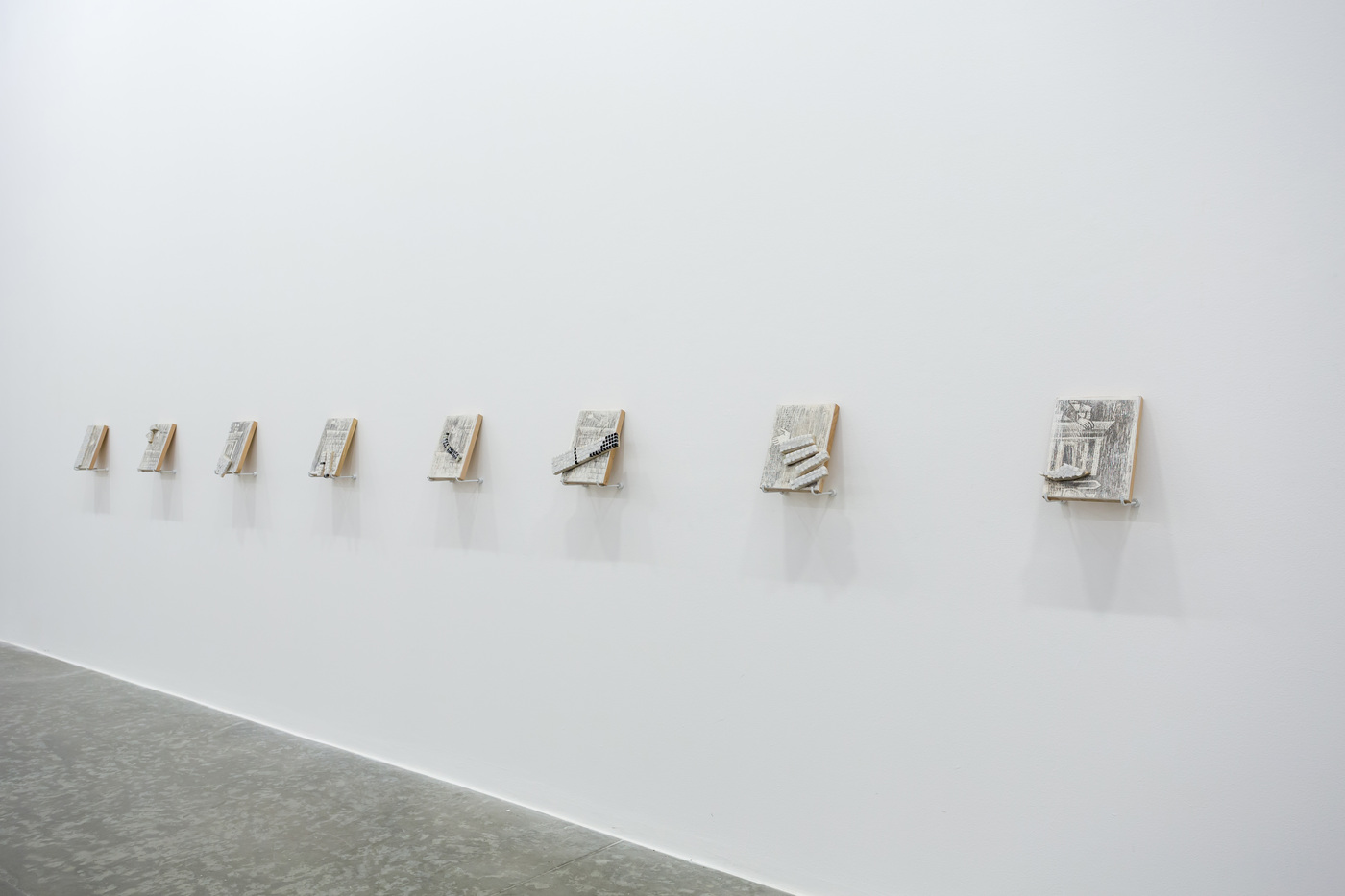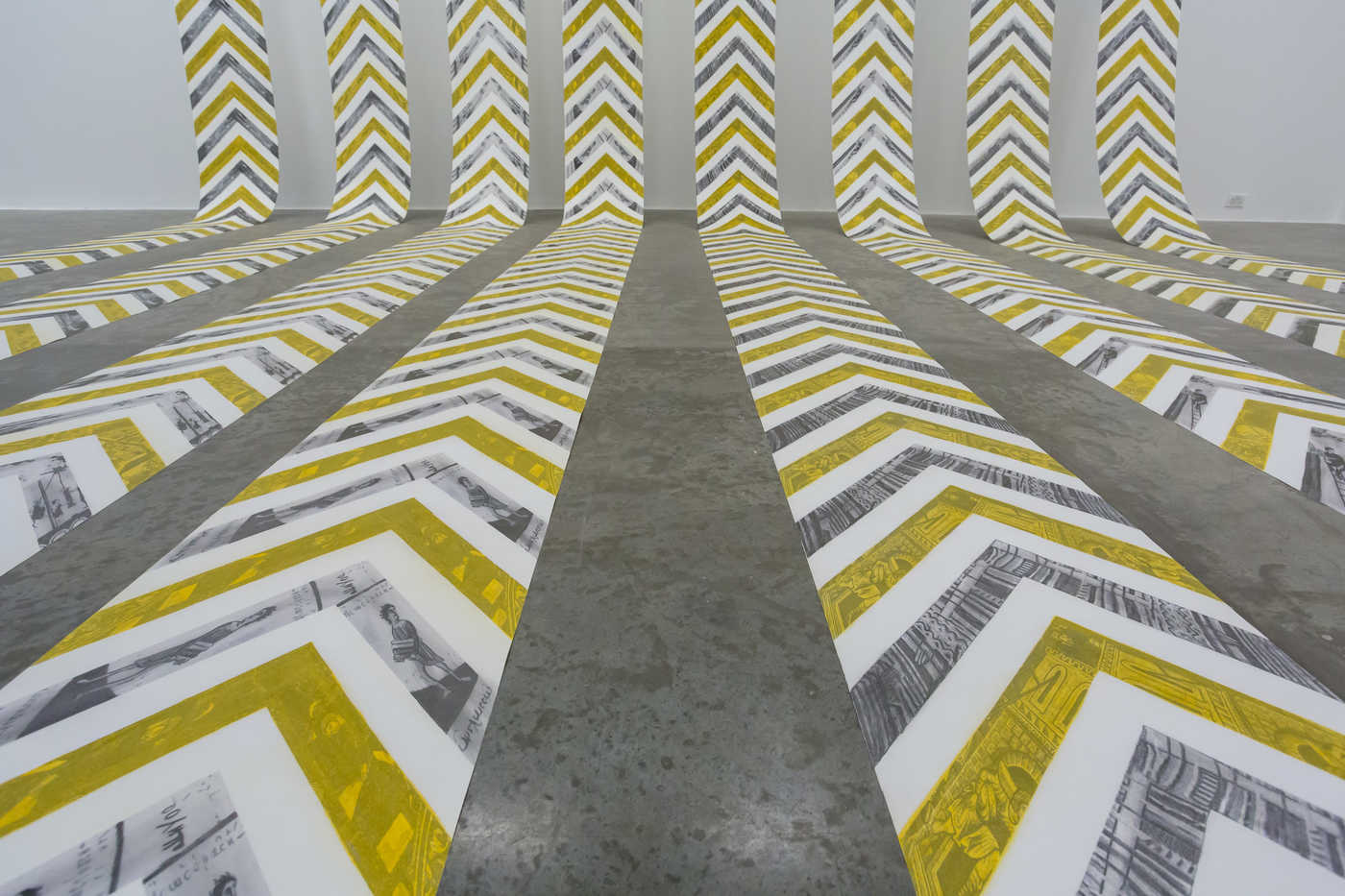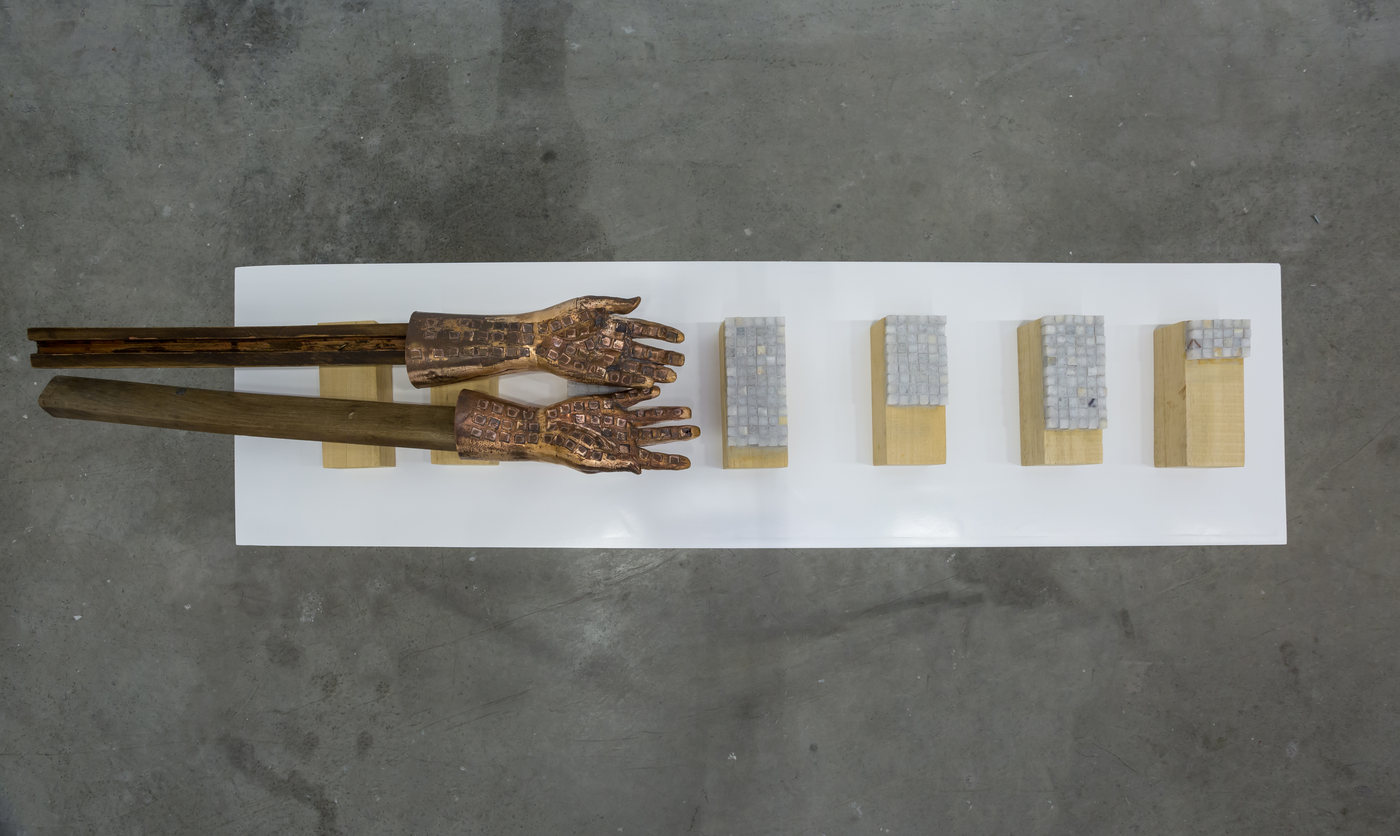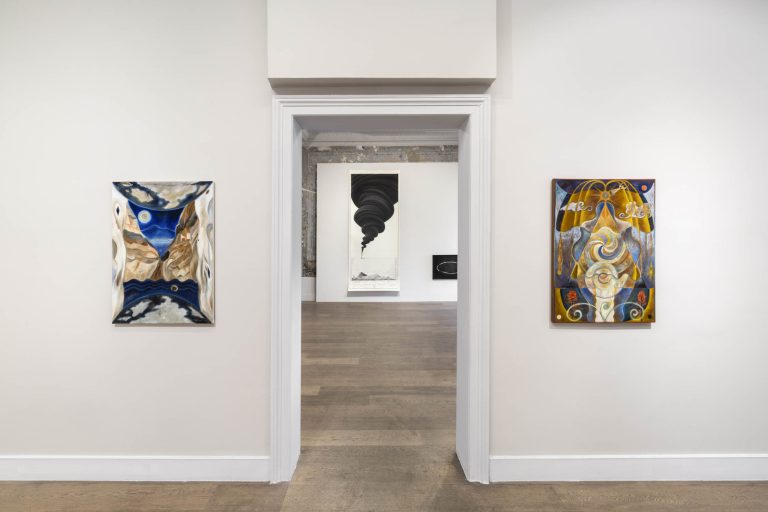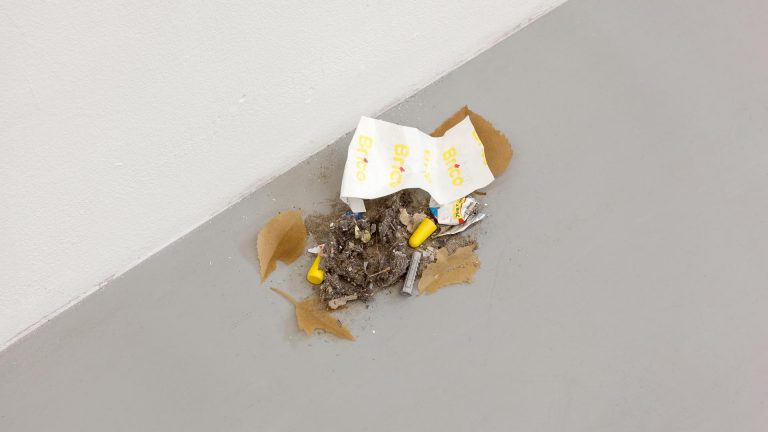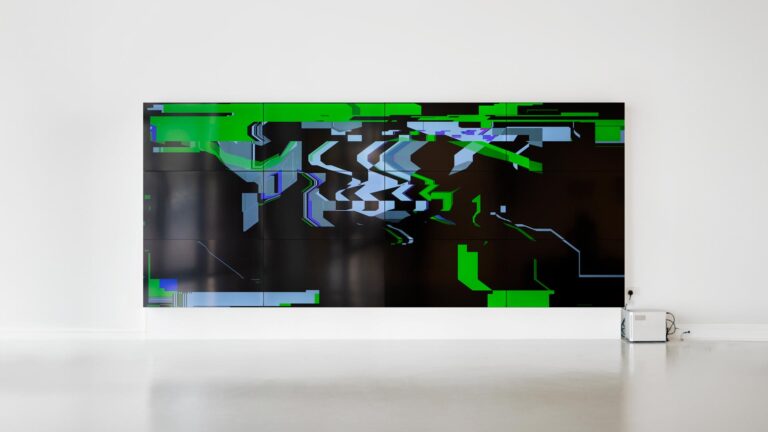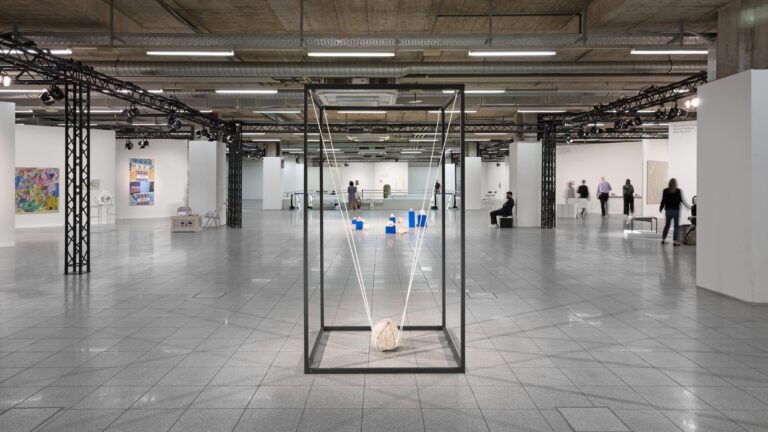Artist: Hera Büyüktaşçıyan
Exhibition title: Write Injuries On Sand And Kindness In Marble
Venue: Green Art Gallery, Dubai, United Arab Emirates
Date: March 13 – May 6, 2017
Photography: all images copyright and courtesy of the artist and Green Art Gallery, Dubai
Green Art Gallery is pleased to present a new solo exhibition of site-specific work by Hera Büyüktaşçıyan, using the lens of aquamorphology to explore the infinite facets and shards of memory, historicity and time.
Tiles spill out of a wall, gliding and oozing across the floor like viscous liquid, pooling into a flat expanse of marble bricks. Elsewhere, bronze arms gleam softly. Covered in marble mosaic pieces, they have the appearance of lustrous scales. On the floor, a great spine of marble slabs moves slowly in the rhythm of the tide, breathing in and out the sighs of yesterday and today. Water is nowhere, yet it is everywhere, an aquamorphological space in which past and present collide in a process of the invisible made visible.
For Hera Büyüktaşçıyan, the term aquamorphology grants water a physical, transformative agency through its collaboration with time. It symbolizes the fluid, aquatic nature of memory, as it can simultaneously purify, divide, connect, heal and destroy. In her solo exhibition at Green Art Gallery, Write Injuries on Sand and Kindness in Marble (13 March – 6 May), Büyüktaşçıyan uses the space’s previous life as a marble factory as a starting point for questions about frameworks of power, labour, production and reconstruction of memory.
Much of Büyüktaşçıyan’s work is defined by an architectural and anthropological approach, and she often favours site-specific installations inspired by the memories found within a place. She examines the way in which virtual spaces operate in relation to the physical, and how fragments of time and memory can be unearthed, restructured and woven together to bring to life a forgotten aspect of time and history. As ever, she also touches on larger issues of geopolitics, culture and ongoing change.
Here, she examines the relationship between labour and productivity. The long-forgotten fingerprints of marble workers trigger deeper questions and reflections on the dynamics of the architecture of power, and the invisible builders whose hands shape the social, urban and historical landscape. Just as Büyüktaşçıyan believes in the functional memory embedded within the marble itself, so too she looks towards the marble workers as the living embodiment of the reconstruction of a virtual space, as each carries within them their own mental space of their own geography.
Büyüktaşçıyan also probes how memories of a space are shaped by waves of power throughout centuries. She brings together people, geographies and timelines in history to link themes of power, production, labour, destruction and invisibility, all through the dual entities of marble and water – two elements that, for the artist, are beyond time.
Everflowing Pool of Nectar, meanwhile, comprises of several large-scale floor-to-ceiling drawings, referencing the now water-less water channels and pools of Mughal architecture in India as a constantly flowing, unfolding memory of architecture. This is complemented by The Discovery of 36 Wells, a series of drawings inspired by Dubai’s newly-built artificial water sources, where an ever-expanding population means ever more must be created. The architectural details comprising these wells are compiled from Istanbul, Athens, Amritsar, Delhi, as well as Dubai – areas where various demographic and economic backgrounds coexist.
Chanting if I live, forgetting it I die, a kinetic sculpture, reminds one of waves of the sea, or a living breathing organism – its breaths connecting yesterday and today through the passage of time. The Relic, meanwhile, features a pair of bronze hands, representing the workers who have metaphorically fused with the marble over time: the repetition of working and cutting and sanding with water has eventually erased their very fingerprints. They embody not just labour, but how we preserve the memory of a space when drastic disappearance and destruction happens.
There is water everywhere, marble everywhere, mosaic fragments in infinite calibrations. They serve as metaphors for fragments of time, in which memory itself is made of up thousands of individual shards. Together, they act as a current, with the infinite power to divide, destroy and connect not just space, but societies, histories and different timelines.
Büyüktaşçıyan was born in Istanbul in 1984, and graduated from Marmara University, Faculty of Fine Arts, Painting department in 2006. Past residencies include Delfina Foundation, London (2014); Villa Waldberta, Munich (2012–13); AIRDrop, Stockholm (2012); PiST/// Interdisciplinary Project Space, Istanbul (2012); and ACSL, Yerevan (2011). She lives and works in Istanbul.
Selected exhibitions include: Write Injuries on Sand and Kindness in Marble, Green Art Gallery, Dubai (2017); Freundschaftsspiel Istanbul: Freiburg, Musum fur Neue Kunst, Germany (2016); 1497, Green Art Gallery, Dubai, UAE (2016); If you can’t go through the door, go through the window, ALT Art space, Istanbul, Turkey (2016); Es war einmal ein Land (Once There was a Country), Heidelberger Kunstverein, Germany (2015); Istanbul: Passion, Joy, Fury, MAXXI, Rome, Italy (2015); GRANDCHILDREN, New geographies of belonging, DEPO, Istanbul, Turkey (2015); Saltwater, Istanbul Biennial, Istanbul, Turkey (2015); Armenity, Armenian Pavillion, 56th Venice Biennale, Venice, Italy (2015); A Century of Centuries, SALT ULUS, Ankara, Turkey (2015); Fishbone, State of Concept, Athens, Greece (2015); The Jerusalem Show, Jerusalem (2014); The Land Across the Blind, Galeri Mana, Istanbul,Turkey (2014); In Situ, PiST///, Istanbul, Turkey (2013); Envy, Enmity, Embarrassment, ARTER, Istanbul, Turkey (2013); Blur, Weltraum, Munich, Germany (2012); Reflecting on Reflection, Galeri Mana, Istanbul, Turkey (2012); Looking for Somewhere to Land, Stockholm, Sweeden (2012); The Afternoon Odyssey, SALT, Istanbul, Turkey (2012); Worthy Hearts, Yerevan, Armenia (2011).
Hera Buyuktasciyan, An Icon of a marble King I, 2016, Wood and marble, 17 x 37 x 8 cm, (6.69 x 14.57 x 3.15 in)
Hera Buyuktasciyan, Chanting if I live, Forgetting it I die, 2017, Kinetic sculpture: Wood and marble, 267 x 30 x 25 cm, (105.12 x 11.81 x 9.84 in)
Hera Buyuktasciyan, Everflowing Pool of Nectar, 2017, Chalk and graphite on paper, 1000 x 50 cm each
Hera Buyuktasciyan, Everflowing Pool of Nectar, 2017, Chalk and graphite on paper, 1000 x 50 cm each
Hera Buyuktasciyan, Icons for builders, 2017, Wood and marble, 26.3 x 20 cm, (10.35 x 7.87 in)
Hera Buyuktasciyan, Icons for builders, 2017, Wood and marble, 21 x 29 cm, (8.27 x 11.42 in)
Hera Buyuktasciyan, Icons for builders, 2017, Wood and marble, 21 x 29 cm, (8.27 x 11.42 in)
Hera Buyuktasciyan, Icons for builders, 2017, Wood and marble, 26.3 x 20 cm, (10.35 x 7.87 in)
Hera Buyuktasciyan, Icons for builders, 2017, Wood and marble, 26.3 x 20 cm, (10.35 x 7.87 in)
Hera Buyuktasciyan, Icons for builders, 2017, Wood and marble, 26.3 x 20 cm, (10.35 x 7.87 in)
Hera Buyuktasciyan, Icons for builders, 2017, Wood and marble, 26.3 x 20 cm, (10.35 x 7.87 in)
Hera Buyuktasciyan, Icons for builders, 2017, Wood and marble, 26.3 x 20 cm, (10.35 x 7.87 in)
Hera Buyuktasciyan, The Discovery of 36 Wells, 2016, Pencil and watercolor on paper, set of 10, 27 x 35 cm each
Hera Buyuktasciyan, The Discovery of 36 Wells, 2016, Pencil and watercolor on paper, set of 10, 27 x 35 cm each
Hera Buyuktasciyan, The Discovery of 36 Wells, 2016, Pencil and watercolor on paper, set of 10, 27 x 35 cm each
Hera Buyuktasciyan, The Discovery of 36 Wells, 2016, Pencil and watercolor on paper, set of 10, 27 x 35 cm each
Hera Buyuktasciyan, The Relic, 2016, Wood, bronze and marble mosaic, Bronze hands: 76 x 20 cm, Wooden blocks: 17 x 7 x 5 cm each, overall size 136 x 20 cm
Hera Buyuktasciyan, The Relic, 2016, Wood, bronze and marble mosaic, Bronze hands: 76 x 20 cm, Wooden blocks: 17 x 7 x 5 cm each, overall size 136 x 20 cm
Hera Buyuktasciyan, The Relic, 2016, Wood, bronze and marble mosaic, Bronze hands: 76 x 20 cm, Wooden blocks: 17 x 7 x 5 cm each, overall size 136 x 20 cm






